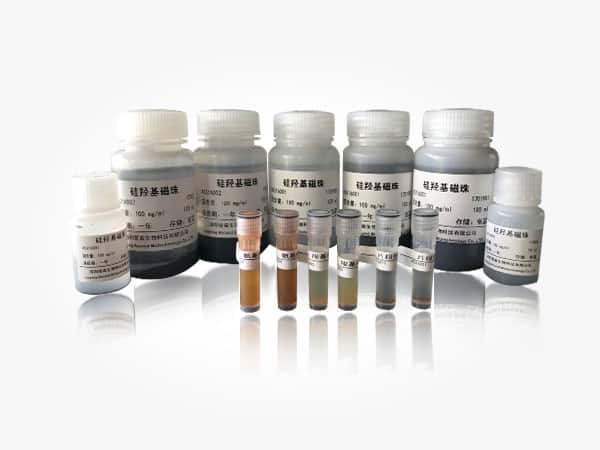What are the functions of immunomagnetic beads?
In recent years, immunomagnetic beads have attracted more and more attention from scientists, and their applications in the field of biomedicine have become more and more extensive. But in fact, immunomagnetic beads are not new products that have only recently developed. As early as the late 1980s, it has begun to play a huge role in the field of cell separation and enrichment.
Immunomagnetic beads generally have super strong paramagnetism. In the presence of an external electric field, the immunomagnetic beads will exhibit magnetism and be aggregated. After leaving the magnetic field, they can be uniformly dispersed like ordinary particles. The surface of immunomagnetic beads generally has abundant surface active groups, and biologically active molecules can be adsorbed or coupled to its surface, so as to realize its use in cell sorting, nucleic acid separation and extraction, immunoassay, biological macromolecule purification and enzyme immobilization, etc. Applications in multiple fields.
Nucleic acid extraction is one of the earliest applications of magnetic beads, and the method has not changed much in decades. By adjusting the pH value of the buffer, the nucleic acid binds to the magnetic beads through electrostatic adsorption. Then, under the condition of an external electric field, the waste liquid is removed and washed, and finally a pure nucleic acid sample can be obtained.
The magnetic bead method avoids steps such as vacuuming and high-speed centrifugation, and can reduce damage to the sample caused by external forces. The magnetic bead extraction method is easy to operate, simple reagents, and suitable for high-throughput automated operations in 96-well plates or 384-well plates.
With the advancement of technology, more and more manufacturers have developed different nucleic acid extraction kits based on immunomagnetic beads. A variety of chemical modifications on the surface of magnetic beads bring the possibility to realize complex experiments.

Cell sorting
Cell sorting is another popular application of immunomagnetic beads. Using immunomagnetic beads combined with markers on the surface of target cells, high-purity target cells can be separated from complex cell mixtures within a few minutes. The immunomagnetic beads will not activate the cells or affect the function and viability of the cells, and the physiological functions of the cells will not change, so the magnetically labeled cells can be used for analysis and subsequent experiments immediately.
Another common method for cell sorting is FACS. In the case of single cell sorting, multiple cell sorting at the same time, or sorting based on intracellular cell markers (such as GFP), FACS method is more advantageous. Compared with FACS, the operation of magnetic bead sorting is simpler and faster. For general cell sorting, the method of immunomagnetic bead can be preferred.
Antibody separation and purification
Traditional antibody separation and purification generally use chromatography, which is cumbersome, time-consuming, high in equipment requirements and high investment costs, while antibody magnetic purification based on protein-coated immunomagnetic beads can achieve expression of products from monoclonal antibodies through simple magnetic adsorption. The purpose of separating monoclonal antibodies. Compared with traditional separation methods, immunomagnetic beads can perform separation and enrichment at the same time, which effectively improves the separation speed and enrichment efficiency. The immunomagnetic beads can also realize automation and mass operation, meet the high-throughput operation requirements of biology, and have the characteristics of convenient use, simple operation, short time and low cost.
Cell stimulation
Immunomagnetic beads also play an important role in cell therapy. In the activation and expansion of T cells and NK cells, antibody or protein-coupled immunomagnetic beads can replace APC, which avoids the tedious operation of cell processing to a certain extent. After completing cell stimulation and activation, the immune magnetic beads can be completely removed by applying a magnetic field. Compared with directly adding antibodies or proteins for stimulation, the residual pollution of soluble antibodies or mitogens is avoided. The same immunomagnetic bead can be coupled to a variety of required antibodies and proteins, and the proximity effect can greatly optimize the effect of cell stimulation and improve the efficiency of cell expansion.
In Vitro Diagnosis
The use of immunomagnetic beads can combine the characteristics of target molecules, and its application methods in in vitro diagnosis are also increasing. First, immunomagnetic beads are used as substrates, which can be used to capture samples. Because the magnetic beads have good fluidity and large surface area, they can fully expose the ligand protein and greatly increase the capture efficiency. At the same time, the use of various detection methods such as fluorescence, electrochemistry, or chemiluminescence also brings a lot of freedom to the development of methodology. In addition, immunomagnetic beads can also be used as markers, and the magnetic properties of magnetic beads can be used to obtain signals. This method generally has extremely high sensitivity, which can reach fg/ml.



